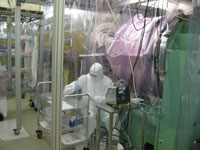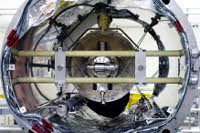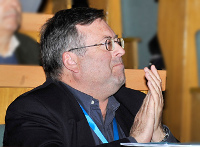From Fermilab Today: AD & TD collaborate on first cryomodule for new facility

A technician performs delicate, particulate-free work in a portable clean room abutting the New Muon Lab's first cryomodule. |
It is perhaps fitting that the New Muon Lab, a long, low concrete affair facing open fields, sits facing the northern edge of Fermilab's property. The hangar-sized building is a busy place these days, home to the laboratory's Superconducting Radio Frequency Test Facility, and bustling with the work that keeps Fermilab pushing the boundary of high-energy particle physics research.
Crews from the laboratory's Accelerator Division and Technical Division recently wrapped up a month-long collaboration at NML on a beamline vacuum system for the facility's first cryomodule, the technology for future particle accelerators such as Project X and the ILC.
Read more...
-- Andrea Mustain |
|
 |
Superconducting cavities could help reducing nuclear waste radio-toxicity

Accelerator-driven system cavity prototype embedded in its cryomodule. Image: Perrine Royole-Degieux. |
What do the ILC and environmental protection have in common? The answer is: superconducting cavities. The European MYRRHA is an experimental facility aimed to demonstrate the technical feasibility of nuclear waste transmutation in an accelerator-driven system. The main part of the accelerator will consist in a series of superconducting cavities. At INFN Milano, Italy, a group has transferred all its experience from the TESLA Technology Collaboration and ILC for the development of elliptical proton cavities for this application. Last month, a prototype cryomodule containing one low-beta elliptical cavity was installed in dedicated test stand at the IPNO/Supratech technological platform in Orsay, France.
Read more...
-- Perrine Royole-Degieux |
 |
|
|
 |
From CERN Bulletin
19 April
LHC status report
Following the great success of the first 3.5 TeV collisions in all four LHC experiments on 30 March, the focus of the LHC commissioning teams has turned to consolidating the beam injection and acceleration procedures.
Read more... |
|
From nature
15 April
Roman ingots to shield particle detector
Lead from ancient shipwreck will line Italian neutrino experiment.
Read more... |
|
From San Francisco Business Times
14 April
Lawrence Berkeley Lab gave Bay Area $690M boost last year
Lawrence Berkeley National Laboratory boosted the Bay Area economy by 5,600 jobs and $690 million last year, according to a study it published this week.
Read more... |
|
|
 |
ILC-CLIC general issues group

Philippe Lebrun, CLIC general issues group co-chair, in Beijing. Image: IHEP/Jie Liu. |
At the Beijing meeting, Philippe Lebrun gave a report to the Global Design Effort Executive Committee of the initial work of the new “ILC-CLIC general issues group.” This working group consists of Philippe Lebrun (co-chair), Ken Peach and Daniel Schulte from the Compact Linear Collider (CLIC) Study, and Mike Harrison (co-chair), Kaoru Yokoya and Eckhard Elsen from the GDE. The group has reviewed its mandate, surveyed the progress of the joint ILC-CLIC working groups and planned its future activities.
Read more...
-- Barry Barish
Director's Corner Archive |
 |
|
|
 |
ILC-Note
2010-053
Ten-TeV e+e- collisions with beamstrahlung compensation for linear collider
2010-052
Multi-TeV upgrade concept for international linear collider based on proton driven plasma acceleration
arXiv preprints
01004.2783
Collider signatures of the Gauge-Higgs Dark Matter
01004.2587
Particle Showers in a Highly Granular Hadron Calorimeter
1004.2188
Electroweak non-resonant NLO corrections to e+ e- → W+ W- b bbar in the t tbar resonance region
|
|

